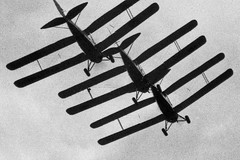Of course it wasn't always HMAS Nirimba. First of all it was land occupied and managed by the Darug peoples for thousands of years.
Post-invasion, 2 land grants were made in 1814 and 1816, to Major West and John Pye respectively, forming the essential extent of the future Schofields Aerodrome, Quakers Hill, site. The land was duly acquired in 1941 as a satellite field to RAAF Richmond. Construction commenced in 1942 but with the formation of the British Pacific Fleet in November 1944 it was decided to allocate the airbase to the Royal Navy (RN) as a MONAB (Mobile Naval Air Base). MONAB III arrived and the base became the RN's HMS Nabthorpe on 5 February 1945. However just a few months later, in November 1945, the RN shut down Brisbane-based MONAB VI, or HMS Nabstock, and transferred most of its personnel and equipment to Schofields. Thus Nabthorpe morphed into Nabstock.
Following the war's end the Royal Navy vacated the base (c.1946). It duly reverted to the RAAF and once again became known as RAAF Schofields. But not for long!
In 1952 the RAN moved in, re-establishing a naval atmosphere. The base was duly commissioned HMAS Nirimba, RANAS Schofields, on 1 April 1953. Or maybe that was Royal Australian Naval Air Repair Yard (RANARY) Schofields. No, it wasn't an April Fool's Day prank. Whilst the plan was to make it an aircraft repair facility as well as an aircraft technical training school, it was the training function that umm, took off.
Why Nirimba? Naval air stations were traditionally assigned the names of sea birds, and the name 'Nirimba' is derived from an Eora Aboriginal word meaning 'pelican'; thus the pelican became the main theme for the HMAS Nirimba crest.
Sadly, according to one source, the responsible Federal politicians and adminstrators were heavily lobbied by the local aviation industry to get out of the aircraft repair and maintenance side of things and, of course let private industry do that instead. And the RAN being about ships not planes (at least in the eyes of some) it came to pass that on January 4, 1956 RANAS Schofields (or was that Royal Australian Naval Air Repair Yard (RANARY) Schofields?) was decommissioned. And on the following day the Royal Australian Navy Apprentice Training Establishment (RANATE) was commissioned instead. To complete the bureaucratic/administrative side of things and lend an air of gentle farce to it all the name Nirimba was also decommissioned on 4 January; but like a Phoenix rising from the ashes, it was recommissioned the very next day.
Of course it didn't last, but it had a good run. Nirimba finally decommissioned - for good, in an RAN sense - on 25 February 1994. In time most of the land, well the southern or building-side of the base, anyway, passed into the hands of the University of Western Sydney and other educational institutions. The name 'Nirimba' thus lives on as an educational precinct.
A good source of naval-era pics here.
When it was operational, both as Nirimba and as a civil airfield, it was probably just a bit too close to RAAF Richmond: big brother was always watching. Although it was a nice, quiet and well-designed place to do touch-and-goes, as I did as a student pilot during the late '70s, you had to be precise. As long as you kept clear of Richmond's airspace and its all-seeing radar, all was fine. But should you cross that invisible line - watch out!
There was an aero club building in the north-east corner and the HMAS Nirimba facility itself to the south. One day in - I think - the early or mid 1970s a DC-3 landed at the strip and parked near the aero club. Before it flew away a fence was erected to cut the long strip somewhat shorter. No, I don't know how it left the field - presumably by truck?
Another Tiger Moth at Schofields, 1976.
Schofields aerodrome was also a motorsport venue from 1950-59 (possibly that conflicts with the RAN records of operation there in 1953, though - shared use?).
The RAAF airfield data c.1944 describes three intersecting, graveled runways with "flight strips" (cleared, grassed and semi-prepared runway) either side. The graveled runways were 150ft wide and measured 3965, 4575 and 5030ft each in length, respectively. The adjacent flight strips were also all 150ft wide but measured 4400, 4975 and 5380ft respectively. In 1944 dispersal was incomplete (no confirmation on completion) and partially constructed hideouts were situated in "sparsely timbered" sections of Quakers Hill. The pre-existing roads of the town were widened and cleared to give enough width to taxi aircraft (to the hideouts!). The graveling of these taxiways was incomplete in 1944. A few huts and old farm houses reportedly occupied the western side of the intersection of two of the flight strips. By 1944 three hideouts were cleared, two were wire meshed and five others were cleared and formed.
Schofields has been closed since c.1994, although some operations were reported up to 1998. Now a housing and educational site, with aerodrome land, including a 'blimp hangar' and remaining portions of runway on sale from 2008. Grab yourself a bit of history.
Selected sources/further reading:
Some more detail available at There's a War On!
Some RAN seabird history
More detail on RN MONABs.
Checkout my list of Sydney and surrounding airstrips and airports.




No comments:
Post a Comment